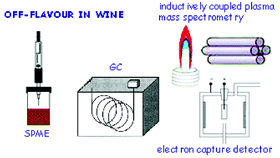“Cork taint”, a musty–mouldy off-odour, represents one of the most serious problems in the wine industry. 2,4,6-Trichloroanisole (TCA), along with other compounds, is known to be responsible for this effect. For this purpose, the present work reports a new method based on headspace solid-phase microextraction (HS-SPME) followed by gas chromatographic (GC) separation and a two-dimensional detection by coupling an electron capture detector (ECD) to an inductively coupled plasma mass spectrometer (ICP-MS) for TCA, 2,6-dichloroanisole (DCA) and 2,4,6-tribromoanisole (TBA) determination. The in-series use of ECD and ICP-MS detectors combine halogen sensitivity from ECD with the selectivity of ICP-MS to confirm these compounds in complex matrices. Different ICP-MS conditions, such as forward power, carrier gas flow and the addition of small percentages of alternate gases have been optimised in the coupling HS-SPME-GC-ECD-ICP-MS. A chemometric approach has been performed for this purpose to obtain the highest sensitivity for all the analytes simultaneously inside the experimental domain. The optimised method shows good detection limits for all the analytes, as well as high precision and sample throughput. Finally, the method has been applied to the analysis of haloanisoles in different red and white Spanish wines. Recovery experiments performed on these matrices proved the method reliability.

You have access to this article
 Please wait while we load your content...
Something went wrong. Try again?
Please wait while we load your content...
Something went wrong. Try again?


 Please wait while we load your content...
Please wait while we load your content...